Technology in Mental Health Statistics: Technology has revolutionized various aspects of our lives, including healthcare.
Recently, there has been increasing recognition of its role in improving mental health outcomes; due to an increase in mental illness prevalence worldwide and treatment gaps, the need for advanced technology is increasing in addressing the mental health of individuals.
Technology in mental health encompasses a wide range of tools and interventions such as mobile apps, online therapy platforms, wearable devices, and artificial intelligence applications.

Table of Contents
- Editor’s Choice
- Global Prevalence of Mental Health Disorders
- Technology in Mental Health Statistics – Tech Adoption
- Technology in Mental Health Statistics – Apps With User Base
- Technology in Mental Health Statistics – Teletherapy and Online Counselling
- Technology in Mental Health Statistics – VR and AR
- Technology in Mental Health Statistics – by Country
- Recent Developments
- Final Thoughts
- FAQ’s
Editor’s Choice
- The Global Mental Health Apps Market size is expected to be worth around USD 23.8 Billion by 2032 from USD 5.2 Billion in 2022, growing at a CAGR of 16.9 % during the forecast period from 2023 to 2032.
- According to a survey on mental wellness conducted in India in May 2022, about 61% of female and 55% of male respondents stated that they had used digital technologies such as apps and smart devices to manage their mental well-being.
- There are more than 10,000 mental health apps available in major app stores.
- About 86% of therapy clients believed that teletherapy sessions are more effective than in-person therapy.
- Artificial Intelligence and machine learning technologies are beneficial in developing predictive models for mental health conditions. AI algorithm could predict the onset of psychosis with 93% accuracy.
- Approximately 44% of individuals with mental health conditions do not receive treatment due to barriers such as stigma, cost, and limited access to providers.
- Around 70% of individuals reported that they would feel comfortable seeking mental health support from a Chatbot.
(Source: Statista, PsyberGuide, American Psychological Association, Nature, National Institute of Mental Health)
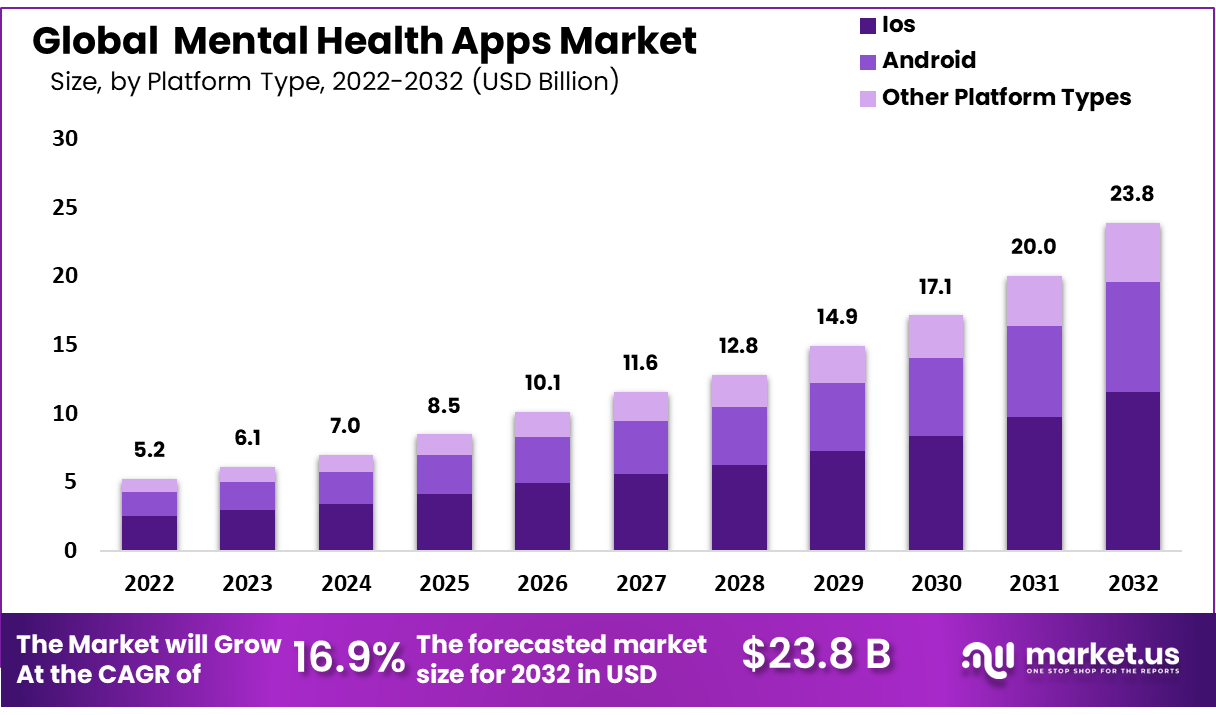
Global Prevalence of Mental Health Disorders
- Around 20% of the world’s children and adolescents have a mental health condition.
- Suicide is the leading cause of death among individuals aged 15-29 years.
- About 1 in 5 people have post-conflict mental health conditions.
- The global median of government health expenditure that goes to mental health is less than 2%.
- The two most common health conditions are depression and anxiety.
- 14.1 million adults aged 18 or older in the United States have Serious Mental Illness.
- SMI prevalence is high among females (7.0%) as compared to males (4.0%).
- Young adults aged 18-25 years had the highest prevalence of SMI which is about 11.4% compared to adults aged 26-49 years (7.1%).
- 9.3% of American Indian/Alaskan Native adults have SMI.
- 8.2% of adults with two or more races have SMI.
- The prevalence of SMI among Asian adults is comparatively low (2.8%).
- 1 in 5 women has a serious mental health disorder.
- 26% of young women aged 16-24 years old reported that they have a common mental health disorder.
- Depression is one of the most common disorders in the United States.
- Around 8.3% of US adults reported a major depressive episode in the last year 2022.
- Around 32% of those in the US with a major depressive episode in the past year had serious thoughts of suicide compared to just 2% of those who did not have any major depressive episode.
- About 1% of the global population is diagnosed with schizophrenia.
- Approximately 1.2% of Americans (3.2 million) have schizophrenia disorder.
(Source: who, nimh.nih, liptemberfoundation, Statista, mental help)

Technology in Mental Health Statistics – Tech Adoption
Technological adoption in mental health has witnessed significant growth in recent years. Various technological solutions are being embraced to improve healthcare delivery, increase healthcare access, and enhance well-being.
- The revenue of mediation apps in India is expected to reach USD 54.99 million by the end of the year 2023.
- It is projected that the user penetration will be 0.13% in 2023 and it is expected to hit 0.15% by 2027.
- About 46% of adults aged 18-34 years have used mental health apps at least once.
- According to Deloitte, there are more than 20,000 mental health apps available on major online platforms.
- Calm and Headspace are the two most popular mental health apps worldwide. The total revenue of the Calm.com mobile app in April 2023 was USD 7 million, including USD 6 million for iOS apps and USD 1 million for Android apps. The total number of Calm app downloaders was 800k in April 2023.
- Around 83% of therapists in the United States recommended mental health apps to their clients.
- Mental health apps are popular among college students. About 60% of students report using mental health apps to manage their well-being.
- Global consumer spending on mental health apps reached USD 270 million in 2020, which is up by 32.5% compared to the previous year. While in 2022, mental well-being apps generated USD 491 million in consumer spending, up by 82.5% compared to 2020.
(Source: Statista, Calm.com, American Psychiatric Association)
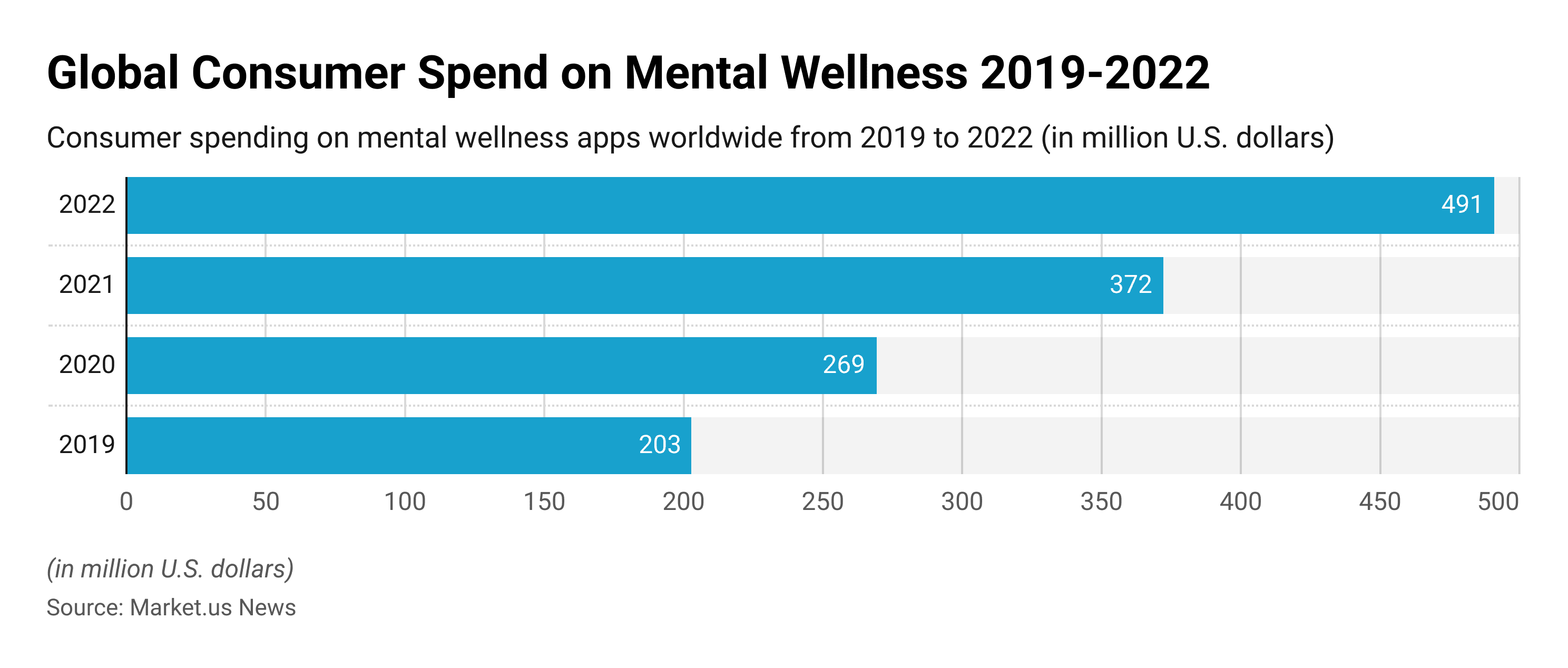
Technology in Mental Health Statistics – Apps With User Base
– Headspace
- Headspace which is a mediation app had 1.32 million downloads worldwide.
- More than 2 million peoples subscribe to Headspace and the app has been downloaded over 65 million times.
- About 2,100 businesses have partnered with Headspace to offer the app for free to employees.
- The revenue of Headspace in 2022 was USD 100.0 million.
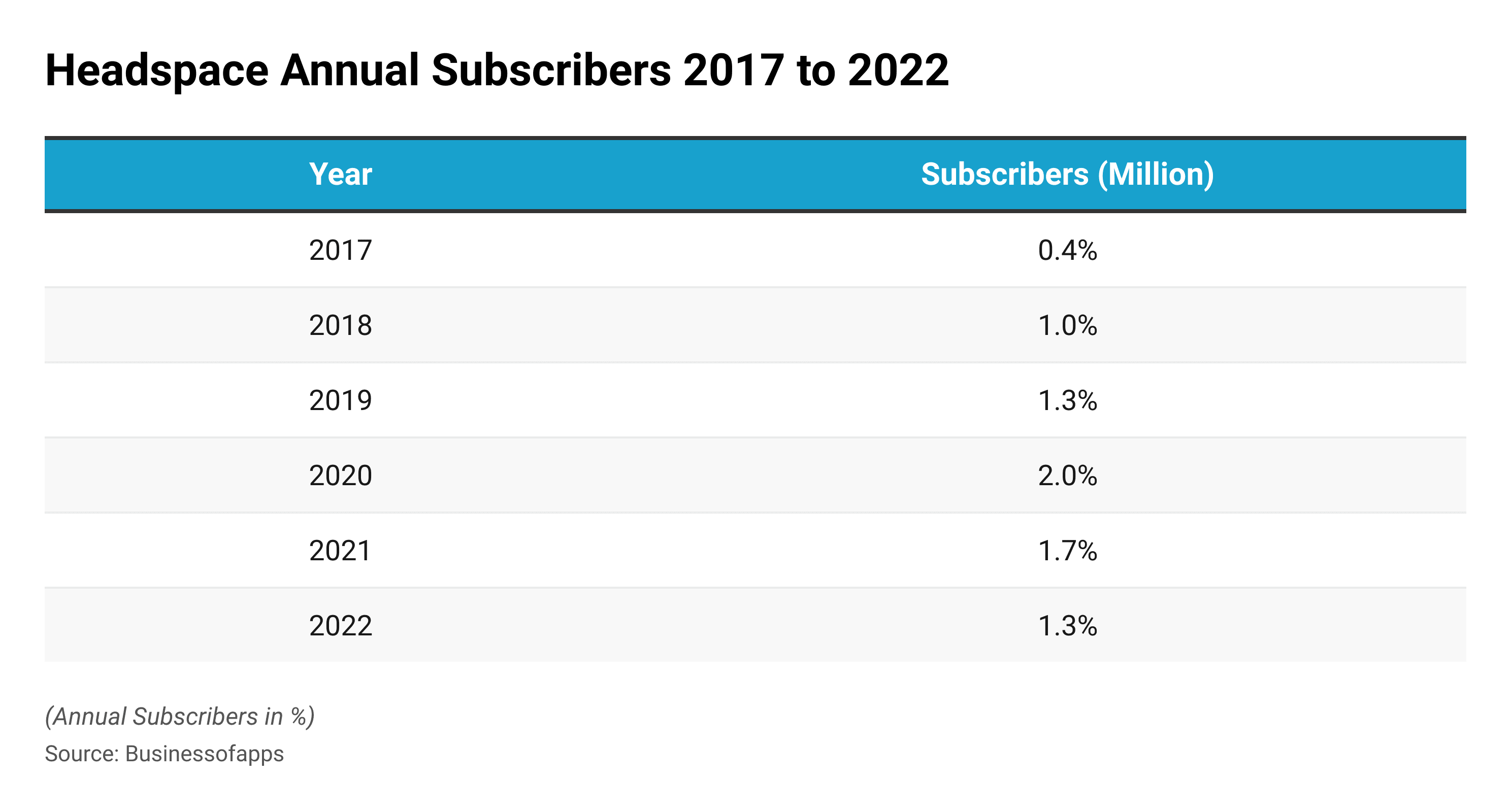
(Source: businessofapps)
– Calm
- In the fourth quarter of 2022, the meditation and mental wellness app Calm amassed a little over 2.33 million downloads worldwide.
- The app has more than 4.7 million subscribers in 2021.
- More than 100 million people worldwide downloaded the Calm app.
- In the fourth quarter of 2022, the leading mental wellness and meditation app Calm generated approximately 20 million U.S. dollars in IAP revenues worldwide.
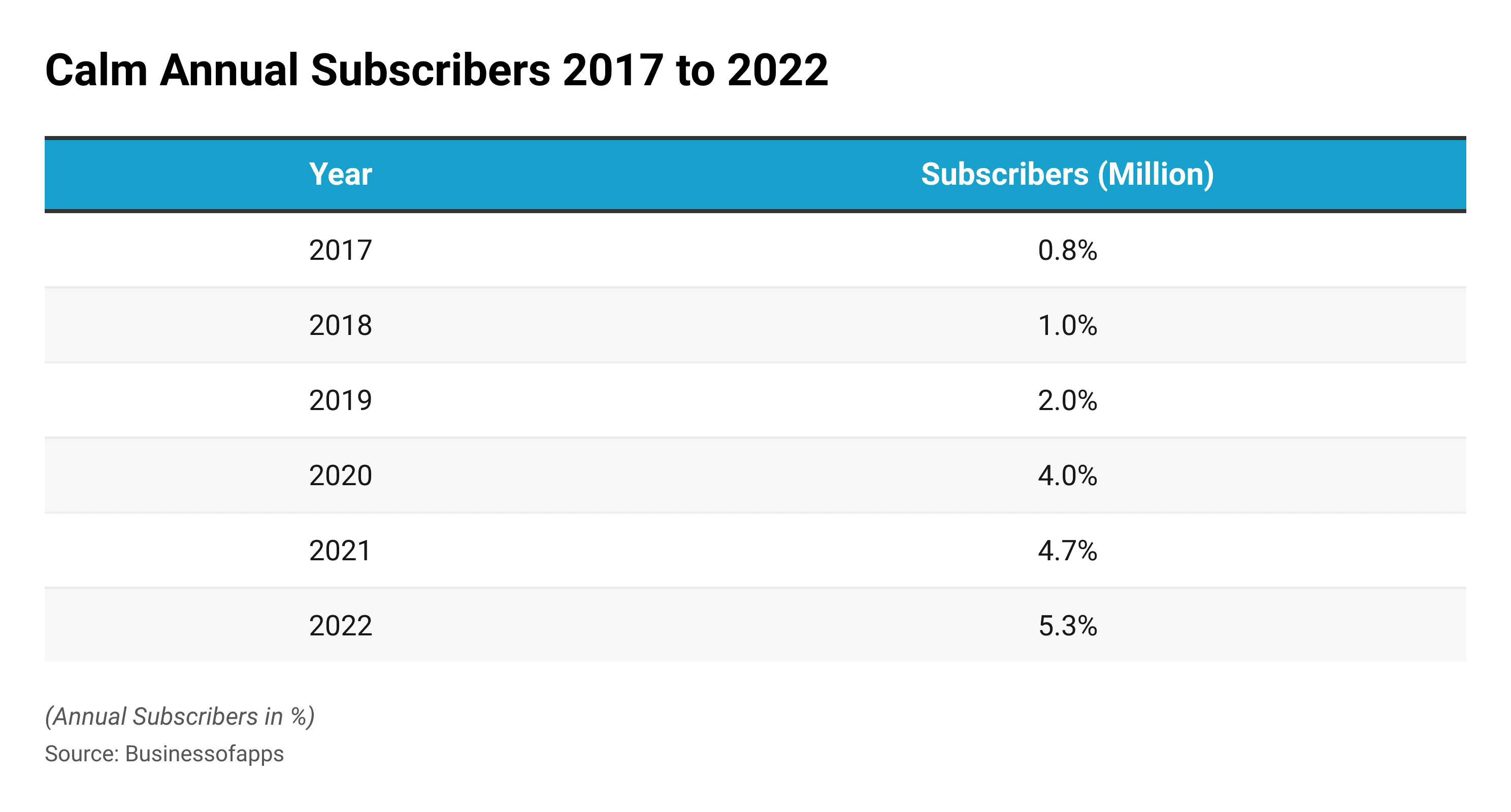
(Source: businessofapps)
– Talkspace
- Talkspace has 42,703 monthly app downloads, according to Apptopia.
- As of March 31, 2022, over 2 million people have used Talkspace, and 76.5 million lives were covered for Talkspace through insurance and employee assistance programs or another network behavioral health paid benefit programs.
- More than 40 million people downloaded the Talkspace app.
- The Talkspace app generated revenue of USD 120 million in the year 2022.
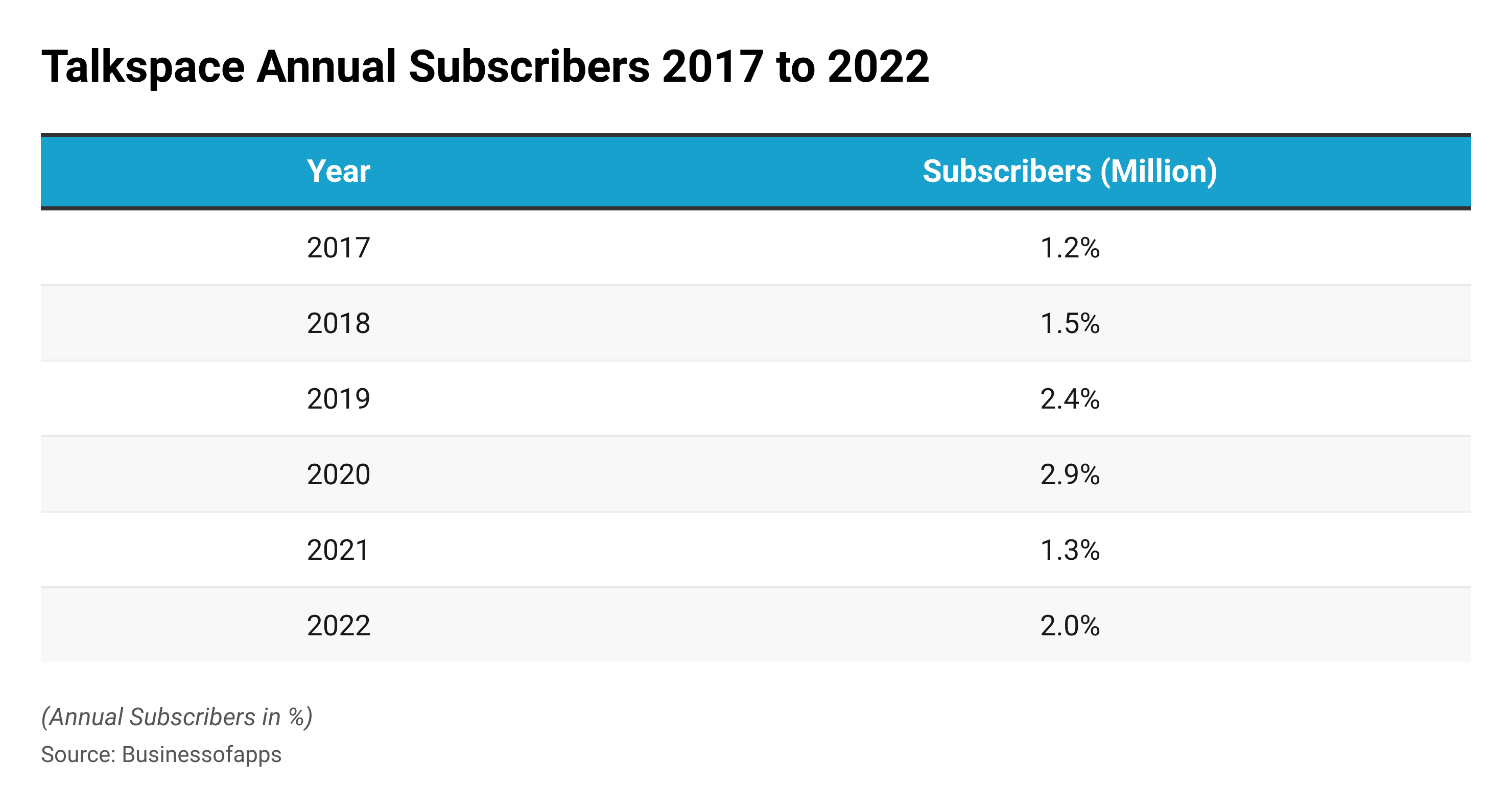
(Source: Talkspace)
Technology in Mental Health Statistics – Teletherapy and Online Counselling
Teletherapy usage has increased significantly in recent years. Teletherapy is effective in treating various mental health conditions. A meta-analysis published in the Journal of Anxiety Disorders in 2018 concluded that teletherapy interventions are generally effective in reducing symptoms of anxiety.
- About 76% of psychologists reported transitioning to teletherapy during the COVID-19 pandemic. (Source: APA)
- The use of teletherapy increased by 12% during the pandemic compared to pre-pandemic levels. (Source: JMIR)
- A study published in the Journal of Clinical Psychology in 2018 found that 91% of clients reported satisfaction with teletherapy services.
- A study published in the Journal of Technology in Behavioral Science in 2020 reported that 84% of clients rated teletherapy as “good” or “excellent” in terms of satisfaction.
- About 85% reported using teletherapy or online counseling as a result of COVID-19. (Source: APA)
- About 76% of Americans believe that online therapy is more effective than in-person therapy. (Source: Pew Research)
According to a study published in the Journal of Affective Disorders (Based on a survey of 1,244 adults)
- 31% of adults reported that teletherapy is very effective in mental health.
- 32% of adults stated that teletherapy is somewhat effective in mental health.
- 17% of adults reported that teletherapy is somewhat ineffective in mental health.
- 10% of adults stated that teletherapy is very ineffective in mental health, while 9% of adults reported that don’t know about teletherapy.
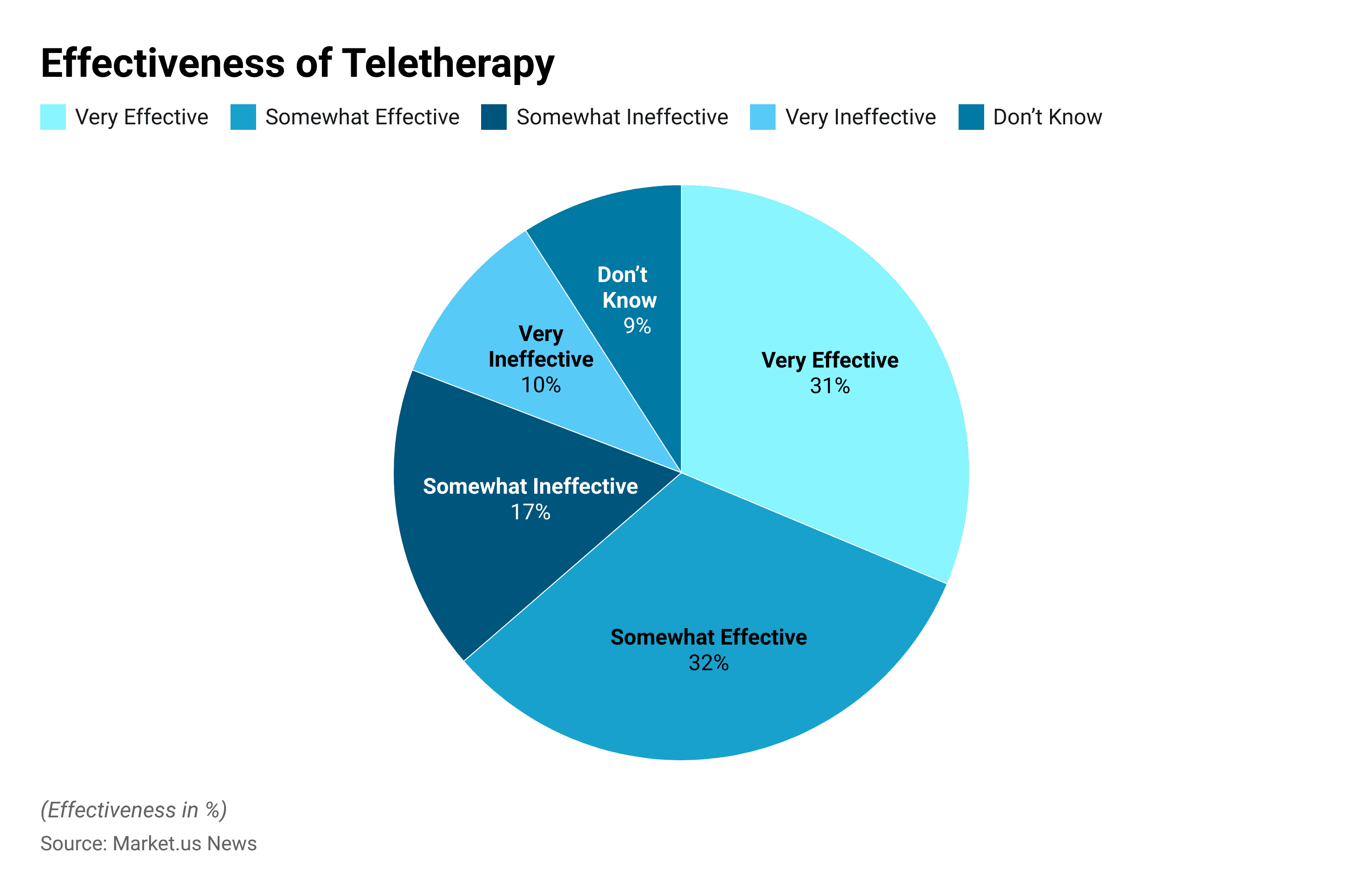
Technology in Mental Health Statistics – VR and AR
AR and VR have been used as distraction tools during medical procedures or chronic pain management. By providing engaging and immersive experiences, they help divert the individual’s attention from the pain, reducing their perception of discomfort and distress.
- In 2018, the global VR in the healthcare market accounted for a revenue of USD 610 million, and the market is projected to reach a revenue of USD 4.2 billion by 2026.
- About 77% of healthcare professionals believe that VR has a positive impact on patient outcomes in medical treatments.
- Around 58% of respondents reported that they are interested in using VR for mental health treatments.
- VR-based exposure therapy was effective in treating social anxiety disorder, with 52% of participants no longer meeting the criteria for the disorder after treatment.
- VR exposure therapy was effective in reducing symptoms of specific phobias, with 90% of participants showing improvement.
(Source: Statista, Virtual Medicine, JMIR, Oxford University, Journal of Anxiety Disorders)
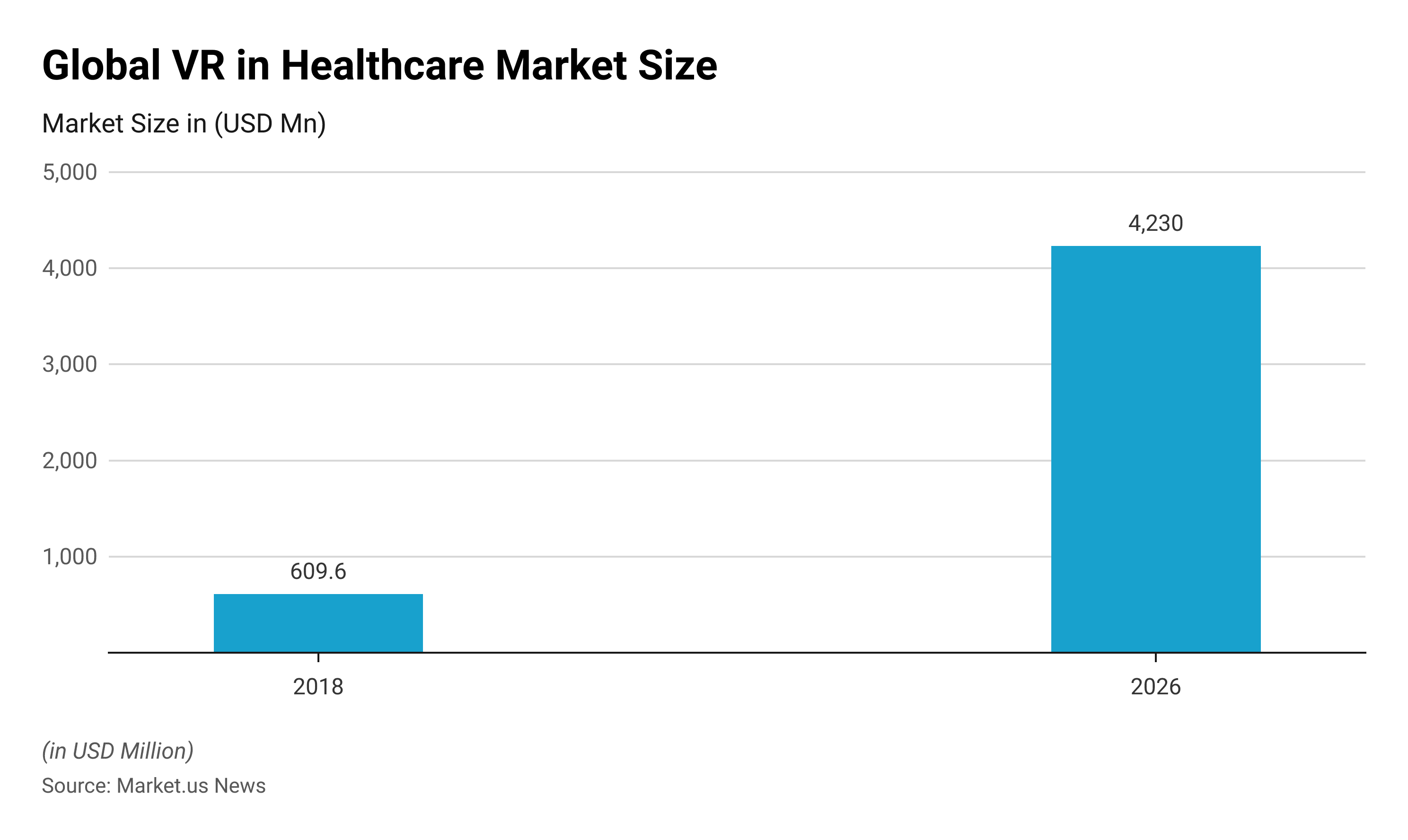

Technology in Mental Health Statistics – by Country
United States
Technology has increasingly played a significant role in the field of mental health in the United States. Teletherapy and telepsychiatry services have gained popularity, particularly in remote or underserved areas, as they allow individuals to receive mental health care through video conferencing or phone calls.
- Around 22% of individuals in the United States receive mental health services via telemedicine.
- According to a survey conducted by the RAND Corporation, telehealth visits for mental health in the United States increased from 0.3% of visits before the pandemic to 35.3% during the pandemic.
- About 29% of Americans have used mental health apps, with 53% of young adults aged 18-24 years.
- Around 7% of individuals in the United States reported receiving mental health services through online platforms.
- In 2021, around 50% of respondents in the United States with a major depressive episode reported they received treatment from a general family doctor.
- 43% of adults in the United States reported that they do not receive mental health services.
- 35% of adults said that they did not know where to go for such services.
- Depression is one of the most common disorders in the United States.
- Around 8.3% of US adults reported a major depressive episode in the last year 2022.
- 75% of women aged 18-20 reported major depressive episodes in 2022 compared to 8.6% of women aged 40-44 years.
- In 2020, a survey carried out in the U.S. found that 35% of adults had used mobile phone or tablet applications to manage their health.
- Around 32% of those in the US with a major depressive episode in the past year had serious thoughts of suicide compared to just 2% of those who did not have any major depressive episode.
(Source: NIHM, APA, SAMHSA, Statista)
Canada
Telehealth has gained prominence in Canada, especially during the COVID-19 pandemic. Mobile applications designed for mental health support have become increasingly popular in Canada.
- About 10% of Canadians reported using online mental health services such as websites or apps.
- The Crisis Text Line, a 24/7 text-based support service, was launched in Canada in 2017. By September 2021, it had handled over 100,000 conversations with texters in Canada.
- In the first quarter of 2022, about 6 out of 10 Russian Generation Z representatives practiced positive thinking to maintain their mental health.
- 58% of representatives practice regularly, 20% do not practice but they realize it’s important, and 22% of representatives think that it is not important to maintain mental wellness.
(Source: Mental Health Commission of Canada, crisis text line, Statista)
According to a survey by Canada Health Infoway,
- 51% of adults are interested in using e-mental health services.
- 37% of adults reported that they are not interested in using e-mental health services.
- 12% of adults reported that they don’t know e-mental health services.
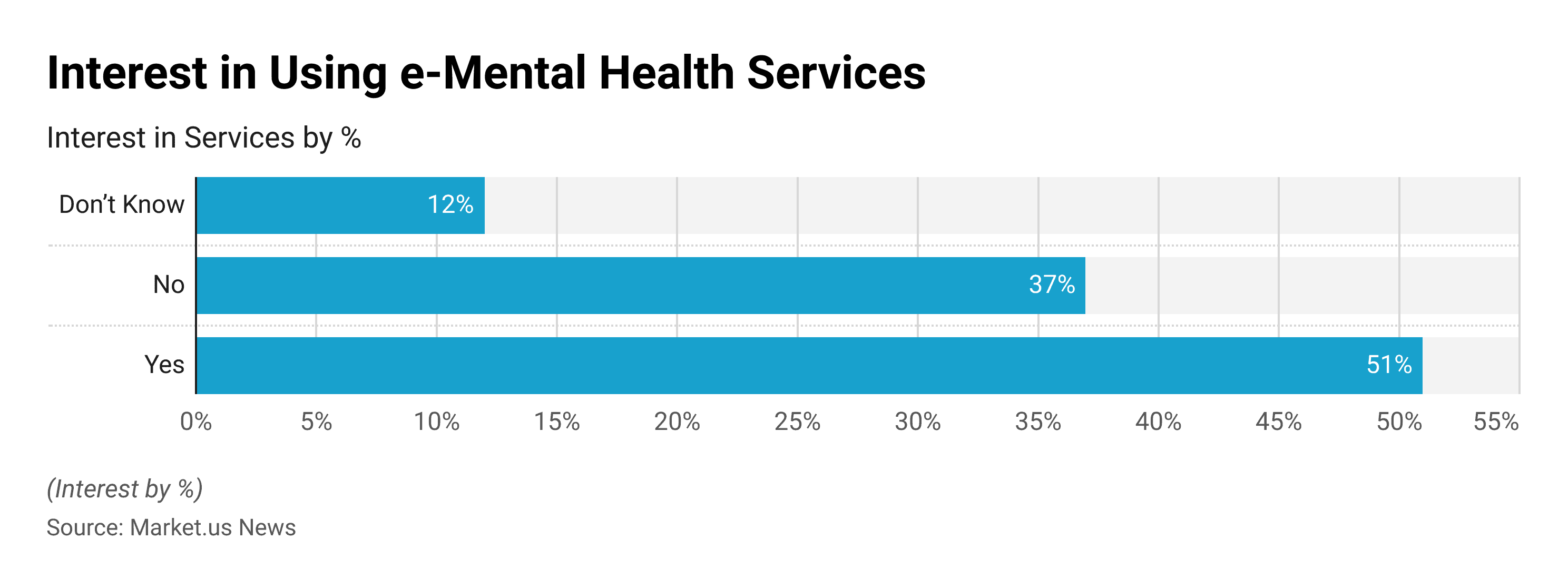
Japan
Online counseling and telepsychiatry services have expanded in Japan, allowing individuals to receive mental health support remotely. Virtual reality has been used in Japan for therapeutic purposes, particularly in the treatment of phobias and post-traumatic stress disorder (PTSD).
- In May 2022, about 26% of respondents in Japan used digital technology such as apps, smart devices, and social media to manage their mental well-being.
- About 44% of respondents state that they regularly exercise to maintain their mental wellness.
- About 37% of respondents in Japan are working on improving their mental wellness, while 23% of respondents are not aware of the term mental wellness.
(Source: Statista)
India
India has witnessed significant growth in internet and mobile phone usage. As of 2021, the number of internet users in India exceeded 624 million, and the number of mobile phone users reached over 1.2 billion.
- About 45% of psychiatrists reported using mental health apps in their practice.
- In 2021, 10% of the population in India will suffer from one or more mental health conditions.
- India accounted for 15% of the global mental, substance abuse, and neurological disorder burden.
- More than 70% to 80% of individuals are suffering from mental illness issues and are struggling with treatment.
(Source: Indian Psychiatry Society, ourbetterworld)
According to a survey by Statista,
- As of May 2022, about 58% of adults aged 35-44 years stated that they started using meditation apps to manage their mental wellness.
- About 54% of respondents aged 25-34 years stated that they started using meditation apps to manage their mental wellness.
(Source: Statista)
Recent Developments
Acquisitions and Mergers:
- MentalHealthTech Inc. acquired MindfulSolutions for $250 million, expanding its foothold in the technology-driven mental health market and integrating innovative digital solutions into its platform.
- TherapyTech merged with WellnessTech, forming a strategic alliance to combine their expertise in mental health technology development and digital wellness solutions, with combined annual revenues projected to surpass $500 million.
New Product Launches:
- MoodTracker introduced a mobile app for mood tracking and emotional regulation, offering personalized insights and coping strategies for users, aiming to reach 1 million downloads within the first year.
- CalmMind launched a virtual reality (VR) meditation experience for stress relief and anxiety management, targeting 500,000 users within six months.
Funding Rounds:
- MentalWellness received $50 million in Series A funding led by Healthcare Investment Group XYZ to scale up their mental health technology platform and invest in artificial intelligence algorithms for personalized interventions, aiming for a 50% increase in user engagement within the next year.
- MindfulTech secured $30 million in seed funding from Tech Investors ABC to develop innovative mental health apps and digital therapeutics for specific mental health disorders, targeting a 40% growth in revenue over the next fiscal year.
Consumer Trends:
- Rising awareness of mental health and wellness fueled the adoption of technology-driven solutions, with downloads of mental health apps increasing by 40% compared to the previous year.
- Teletherapy sessions surged during the COVID-19 pandemic, with a 50% increase in virtual counseling sessions and online therapy consultations, reflecting growing acceptance of remote mental health care.
Regulatory Landscape:
- Regulatory agencies implemented guidelines for mental health technology approval and data privacy, ensuring adherence to quality standards and user confidentiality in digital mental health interventions.
Investment in Research and Development:
- Technology companies and mental health organizations allocated significant resources to research and development in mental health technology, with an estimated $3 billion invested globally in digital mental health advancements and market expansion initiatives.
Final Thoughts
Technology in Mental Health Statistics – Technology has emerged as a powerful tool in addressing mental health challenges worldwide. Teletherapy and online counseling have witnessed a tremendous increase in usage, especially during the COVID-19 pandemic. Virtual Reality and Augmented Reality have shown potential in mental health treatment.
Technology has the potential to revolutionize mental healthcare by addressing barriers such as stigma, cost, and limited access to providers.
The widespread adoption of technology in mental health, along with its effectiveness and growing user base, highlights its significant role in improving mental health outcomes worldwide.
FAQ’s
Technology in mental health refers to the use of various technological tools and applications to support mental health assessment, diagnosis, treatment, and management. It includes digital platforms, mobile applications, wearable devices, teletherapy, online support groups, and virtual reality therapy, among others.
AR and VR have been used as distraction tools during medical procedures or chronic pain management. By providing engaging and immersive experiences, they help divert the individual’s attention from the pain, reducing their perception of discomfort and distress.
Online therapy, also known as teletherapy or e-therapy, involves providing mental health counseling and support remotely through digital platforms. This can include video conferencing, instant messaging, or email exchanges with licensed therapists. Online therapy can offer convenience, increased accessibility, and privacy for individuals seeking mental health support.
Discuss your needs with our analyst
Please share your requirements with more details so our analyst can check if they can solve your problem(s)



